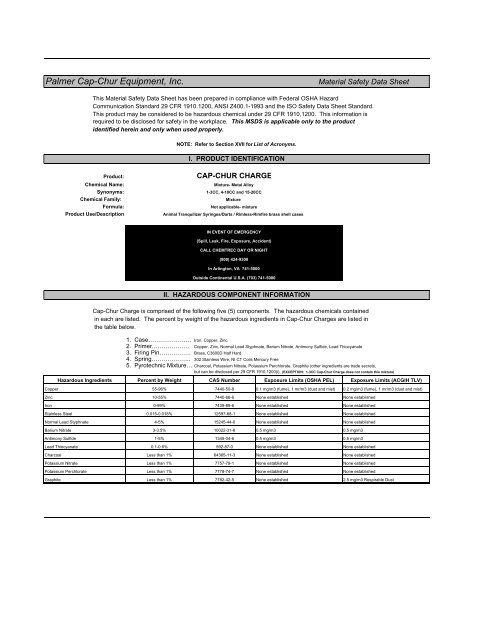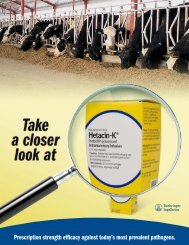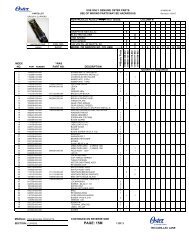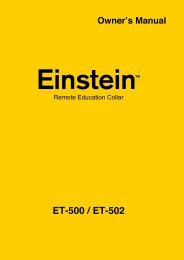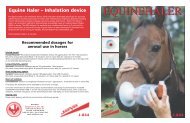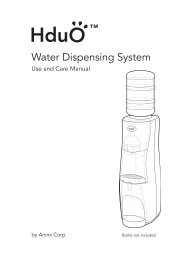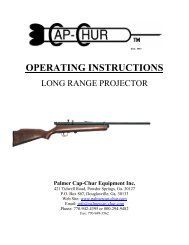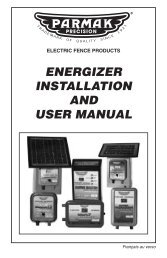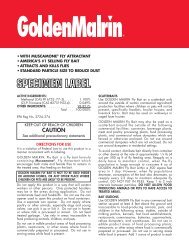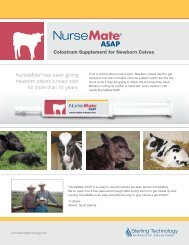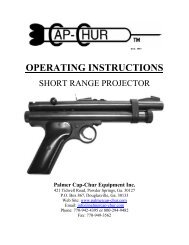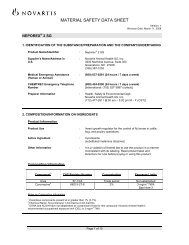Cap-Chur Charges - Valley Vet Supply
Cap-Chur Charges - Valley Vet Supply
Cap-Chur Charges - Valley Vet Supply
Create successful ePaper yourself
Turn your PDF publications into a flip-book with our unique Google optimized e-Paper software.
Palmer <strong>Cap</strong>-<strong>Chur</strong> Equipment, Inc. Material Safety Data Sheet<br />
This Material Safety Data Sheet has been prepared in compliance with Federal OSHA Hazard<br />
Communication Standard 29 CFR 1910.1200, ANSI Z400.1-1993 and the ISO Safety Data Sheet Standard.<br />
This product may be considered to be hazardous chemical under 29 CFR 1910,1200. This information is<br />
required to be disclosed for safety in the workplace. This MSDS is applicable only to the product<br />
identified herein and only when used properly.<br />
Product:<br />
Chemical Name:<br />
Synonyms:<br />
Chemical Family:<br />
Formula:<br />
Product Use/Description<br />
NOTE: Refer to Section XVII for List of Acronyms.<br />
I. PRODUCT IDENTIFICATION<br />
CAP-CHUR CHARGE<br />
Mixture- Metal Alloy<br />
1-3CC, 4-10CC and 15-20CC<br />
Mixture<br />
Not applicable- mixture<br />
Animal Tranquilizer Syringes/Darts / Rimless-Rimfire brass shell cases<br />
IN EVENT OF EMERGENCY<br />
(Spill, Leak, Fire, Exposure, Accident)<br />
CALL CHEMTREC DAY OR NIGHT<br />
(800) 424-9300<br />
In Arlington, VA 741-5000<br />
Outside Continental U.S.A. (703) 741-5000<br />
II. HAZARDOUS COMPONENT INFORMATION<br />
<strong>Cap</strong>-<strong>Chur</strong> Charge is comprised of the following five (5) components. The hazardous chemicals contained<br />
in each are listed. The percent by weight of the hazardous ingredients in <strong>Cap</strong>-<strong>Chur</strong> <strong>Charges</strong> are listed in<br />
the table below.<br />
1. Case…………………. Iron, Copper, Zinc<br />
2. Primer………………. Copper, Zinc, Normal Lead Styphnate, Barium Nitrate, Antimony Sulfide, Lead Thiocyanate<br />
3. Firing Pin……………. Brass, C3600D Half Hard<br />
4. Spring……………….. 302 Stainless Wire, NI CT Coils Mercury Free<br />
5. Pyrotechnic Mixture….Charcoal, Potassium Nitrate, Potassium Perchlorate, Graphite (other ingredients are trade secrets,<br />
but can be disclosed per 29 CFR 1910.1200(i). (EXCEPTION: 1-3CC <strong>Cap</strong>-<strong>Chur</strong> Charge does not contain this mixture) .<br />
Hazardous Ingredients Percent by Weight CAS Number Exposure Limits (OSHA PEL) Exposure Limits (ACGIH TLV)<br />
Copper 55-96% 7440-50-8 0.1 mg/m3 (fume), 1 mr/m3 (dust and mist) 0.2 mg/m3 (fume), 1 mr/m3 (dust and mist)<br />
Zinc 10-55% 7440-66-6 None established None established<br />
Iron 0-99% 7439-89-6 None established None established<br />
Stainless Steel 0.015-0.018% 12597-68-1 None established None established<br />
Normal Lead Styphnate 4-5% 15245-44-0 None established None established<br />
Barium Nitrate 3-3.5% 10022-31-8 0.5 mg/m3 0.5 mg/m3<br />
Antimony Sulfide 1-5% 1345-04-6 0.5 mg/m3 0.5 mg/m3<br />
Lead Thiocyanate 0.1-0.6% 592-87-0 None established None established<br />
Charcoal Less than 1% 64365-11-3 None established None established<br />
Potassium Nitrate Less than 1% 7757-79-1 None established None established<br />
Potassium Perchlorate Less than 1% 7778-74-7 None established None established<br />
Graphite Less than 1% 7782-42-5 None established 2.5 mg/m3 Respirable Dust
Emergency Overview: Accidental fire may cause low-energy fragments to be emitted thus causing<br />
potential eye injury.<br />
Potential Human Health Effects:<br />
Skin Contact: May cause allergic reaction (sensitization) in susceptible individuals.<br />
Eye Contact: Dust and fumes can irritate the eyes causing redness and discharge.<br />
Inhalation: Inhalation of dust or fumes may cause irritation to nose, throat, upper<br />
respiratory tract and lungs. Irritation may lead to bronchitis, headache,<br />
lowering of blood pressure and weakness.<br />
Ingestion/Absorption: Ingestion may cause severe headache, nausea, vomiting, abdominal<br />
pain, fatigue, diarrhea, trembling, rining in ear and salivation.<br />
Carcinogenicity Information:This product is not classified a carcinogen by IARC, OSHA, NTP or<br />
EPA.<br />
Skin Contact: Wash affected area thoroughly with soap and water. Remove contaminated<br />
clothing. Wash clothing thoroughly prior to reuse. Discard any contaminated<br />
leather items (i.e. shoes, etc.).<br />
Eye Contact: If wearing contacts, immediately remove contact lenses. Hold eyelids apart and<br />
flush eyes thoroughly with water for at least 15 minutes. Obtain medical<br />
attention immediately.<br />
Inhalation: Immediately remove to fresh air. Administer artificial respiration, if necessary.<br />
If breathing is difficult, administer oxygen. Obtain medical attention<br />
immediately.<br />
Ingestion/Absorption If conscious, drink large amounts of water. Induce vomiting. Immediately<br />
contact a physician or Poison Control Center. Never induce vomiting or give<br />
anything by mouth to an unconscious person.<br />
Flammable Properties: May ignite if heated to 150F. Will ignite when exposed to flame and high<br />
temperatures. Be cautious of low-energy fragments.<br />
Extinguishing Media: Flood fire with water to fight fire and cool shells. If no water is available,<br />
use carbon dioxide, dry chemical or earth.<br />
Fire-Fighting Instructions: Evacuate area immediately. Deluge area with water. Wear full fire-fighting<br />
protective gear including face shield or SCBA to protect from fragments.<br />
Safeguards: Remove from all sources of ignition.<br />
III. HAZARDS IDENTIFICATION<br />
IV. FIRST AID MEASURES<br />
V. FIRE HAZARDS<br />
VI. ACCIDENTAL RELEASE MEASURES
Spill Cleanup: Use non-sparking equipment to clean up spill. If disposal is necessary, refer<br />
to XIII. DISPOSAL CONSIDERATIONS.<br />
Accidental Release: See above.<br />
Personnel Handling: Handle with care. Do not strike or crush the rounds. Always wash hands<br />
thoroughly after handling. Safety glasses recommended when handling or<br />
firing rounds. Do not drop. Do not subject to mechanical shock.<br />
Storage: Store in original containers in a cool, dry, well-ventilated area away from all<br />
sources of ignition. Do not subject to mechanical shock. Keep out of reach<br />
of children. This product must not be stored with acids, metal powders, strong<br />
oxidizers or caustics.<br />
Engineering Controls: Local exhaust ventilation is recommended if significant dusting occurs.<br />
Otherwise, use general exhaust ventilation.<br />
Personal Protective<br />
Equipment: Safety glasses recommended when handling or firing rounds.<br />
Hearing protection recommended when firing rounds.<br />
Use of NIOSH/MSHA-approved respirator is recommended when<br />
concentrations to fumes and/or dust exceed the PEL or TLV.<br />
Exposure Guidelines: Keep product away from sources of accidental ignition.<br />
Exposure Limits: Exposure limits listed with each hazardous chemical.<br />
PHYSICAL DATA<br />
VII. HANDLING AND STORAGE<br />
VIII. PERSONAL PROTECTION/EXPOSURE CONTROLS<br />
IX. PHYSICAL AND CHEMICAL PROPERTIES<br />
Form: Solid Evaporation Rate: N/A<br />
Color: Variable Melting Point: N/A<br />
Odor: None Solubility in Water: N/A<br />
Boiling Point: N/A pH: N/A<br />
Specific Gravity: N/A<br />
Vapor Pressure: N/A<br />
Vapor Density: N/A<br />
X. STABILITY AND REACTIVITY<br />
Chemical Stability: Stable under normal use conditions. Will not react with water.<br />
Other Hazards:<br />
Incompatibility: Incompatible with acids, strong oxidizers and caustics.<br />
Polymerization: Will not occur.<br />
Conditions to Avoid: Flames, sparks, percussion, shock, static, high temperatures (150F or 65C, or<br />
above)<br />
XI. TOXICOLOGICAL INFORMATION<br />
For Product: For Components<br />
Copper<br />
3.5 mg/kg (mouse,<br />
Zinc Iron<br />
Oral LD50 Not applicable for product<br />
intraperitoneal)<br />
375 mg/kg (rabbit,<br />
No data 30 g/kg (rat)<br />
Dermal LD50 Not applicable for product<br />
subcutaneous) No data No Data<br />
Not applicable for product. Particles<br />
Inhalation LC50<br />
generated from firing may be slightly toxic. No data No data No data<br />
Irritation Not a skin or eye irritant as a solid Respiratory irritant No data Eye irritant
Aquatic Toxicity:<br />
Lead (LC 50) to Bluegill: 2-5 mg/l<br />
Barium to Stickleback: 400 mg/l<br />
Barium Nitrate to Stickleback: 760 mg/l<br />
Copper: The toxicity of copper to aquatic organisms varies significantly not only with the species, but also with the physical and chemical<br />
characteristics of the water, such as its temperature, hardness, turbidity and carbon dioxide content. Copper concentration varying from<br />
0.1 to 1.0 mg/l have been found by various investigators to be not toxic for most fish. However, concentrations of 0.015 to 3.0 mg/l have been reported<br />
as toxic, particularly in softwater to many kinds of fish, crustacea, mollusks, insects and plankton.<br />
Zinc: The following concentrations of zinc have been reported as lethal to fish:<br />
Rainbow trout fingerlings: 0.13 mg/l, 12 - 24 hours<br />
Bluegill sunfish: 6 hr TLM = 1.9 - 3.6 mg/l (soft water, 30 C)<br />
Sticklebacks: 1 mg/l (soft water) 24 hrs.<br />
The presence of copper appears to have a synergistic effect on the toxicity of zinc towards fish.<br />
Environmental Impact:<br />
When used and disposed of properly, there is no known environmental impact.<br />
This product is considered a chacteristic hazardous waste per 40 CFR 261.24 for disposal purposes only.<br />
Dispose of as required by local, state and federal laws and regulations for disposal of hazardous and non-hazardous wastes.<br />
EPA Hazardous Waste Code: D008 (lead)<br />
SHIPPING INFORMATION<br />
Proper Shipping Name: Cartridges for Weapons, Inert Projectile<br />
Hazard Class: 1.4S<br />
UN/NA No: UN0012<br />
Packing Group: II<br />
Shipping Label: 1.4S Label<br />
Special Information: EX-8805210<br />
NFPA Rating: Not Established<br />
HAZARD CLASSIFICATION:<br />
Chronic Health: Headache, nausea, weakness<br />
Acute Health: Anemia, embryotoxin<br />
Fire Hazard: 0 (per HMIS Rating)<br />
Pressure Hazard: Sudden release of pressure.<br />
Reactivity Hazard: 0 (per HMIS Rating)<br />
NPCA-HMIS Ratings:<br />
Health: 2<br />
Flammability: 3<br />
Reactivity: 4<br />
Explosive: 2<br />
References:<br />
Material Safety Data Sheet, Olin Winchester Ammunition, January 18, 2008,<br />
Olin MSDS No.: 00060.0001, Revision No.: 13<br />
Material Safety Data Sheet, Olin Winchester Ammunition, January 18, 2008,<br />
Olin MSDS No.: 00069.0001, Revision No.: 11<br />
Material Safety Data Sheet, U. S. Department of Labor<br />
XII. ECOLOGICAL INFORMATION<br />
XIII. DISPOSAL CONSIDERATIONS<br />
XIV. TRANSPORTATION INFORMATION<br />
XV. OTHER INFORMATION
Material Certification, Industrial Steel & Wire Co., October 13, 2004<br />
878315-00<br />
Chemical Analysis/Mechanical Test, Bolion Metal Products, Bellefonte Works,<br />
ISO 9001:2000 Registered<br />
For additional information, please contact:<br />
Palmer <strong>Cap</strong>-<strong>Chur</strong> Equipment, Inc.<br />
P.O. Box 867, Douglasville, GA 30135<br />
421 Tidwell Road, Powder Springs, GA 30127<br />
(800) 294-9482<br />
The information contained in this Material Safety Data Sheet is provided to all individuals who are or will be exposed<br />
to this product through use, handling, storage or transport. Palmer <strong>Cap</strong>-<strong>Chur</strong> Equipment, Inc. believes, yet makes no<br />
warranty, that all information contained in this document is current as of the date of publication.


